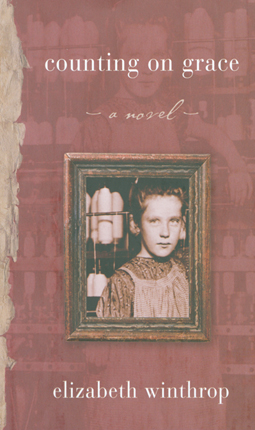Full Text Reviews: School Library Journal - 03/01/2006 Gr 5-8-Inspired by Lewis Hine's haunting photograph of a French Canadian girl in Vermont in 1910, Winthrop's compelling story vividly captures the mill experience. Grace Forcier and her friend Arthur, both 12 and the best readers in the mill school, are forced to suspend their educations to doff bobbins for their mothers' frames in the spinning room. While this is difficult for left-handed Grace, Arthur is desperate to escape the stuffy, sweaty, linty, noisy factory. Miss Lesley, their teacher, helps them write a letter to the National Child Labor Committee about underage kids, as young as eight, working in their mill. Grace understands the dilemma a response will cause. If the children don't work, the families won't have enough money to survive. Lewis Hine is the answer to the letter. He comes and photographs the mill rats, as the kids are called; no one will believe the conditions without pictures. Arthur, however, can wait no longer to carry out his escape plan. In a horrifying scene, he jams his right hand into the gearbox of the frame, painfully mangling it and losing two fingers. Miss Lesley's interference causes her to be fired, and she encourages Grace to be the substitute teacher, leaving readers with a sense that she will escape the mill and have a better life. Much information on early photography and the workings of the textile mills is conveyed, and history and fiction are woven seamlessly together in this beautifully written novel. Readers won't soon forget Grace.-Connie Tyrrell Burns, Mahoney Middle School, South Portland, ME Copyright 2006 Reed Business Information. - Copyright 2006 Publishers Weekly, Library Journal and/or School Library Journal used with permission. Bulletin for the Center... - 03/01/2006 Twelve-year-old Grace Forcier has always known she will join her family at their work in a Vermont cotton mill, and although her teacher, Miss Lesley, struggles to keep her and gifted classmate Arthur in school, Grace is just as happy to be bringing in an income. Arthur, however, resists millwork, even though he realizes he must help his widowed mother at the looms and that their company housing depends on every able-bodied person in the household taking employment at the mill. He and Miss Lesley draw Grace into their scheme to report underage laborers to the National Child Labor Committee, and in response to their letter, Lewis Hine is sent to document abuses via photos and testimony. Results don’t come fast enough for Arthur, though, and he purposely mangles his fingers in a loom to escape working and return to the classroom. Even that’s not enough; after he heals, the company expects him to push a broom. Winthrop refuses to downplay the consequences of resisting company policy in an early twentieth-century industrial town—Miss Lesley is fired and Arthur and his mother forced to move on. There’s a shred of hope for Grace, though: she takes a temporary position as substitute teacher with the blessing of her parents, who now realize education is the best longterm strategy for their daughter. Closing notes discuss the Hine photograph of millworker Addie Cird that served as inspiration for this story. - Copyright 2006 The Board of Trustees of the University of Illinois. Booklist - 02/15/2006 Inspired by a Lewis Hine photo of a child at work in a Vermont cotton mill in the early twentieth century, Winthrop imagines the story of Grace, 12, torn from her one-room schoolhouse and forced to work long hours in the textile mill as a doffer, turning cotton into thread, alongside her mother, in the spinning room. The child-labor story is gripping--the dangerous working conditions, the work of activists who sought to publicize the abuse--and although sometimes the research overwhelms the story, Grace's present-tense narrative makes the history heartbreaking. Grace is no sweet victim. Furious at having to leave school and distressed by her failure to satisfy her French Canadian immigrant family, she quarrels with her best friend and smart ex-classmate, who deliberately injures himself on the machines to get back in school. The fiction is framed by notes about Hine and a bibliography that will lead readers to such books as Russell Freedman's Kids at Work: Lewis Hine and the Crusade against Child Labor (1994) as well as to accounts of abuse today. - Copyright 2006 Booklist. Loading...
|



